Did the Shroud of Turin serve as an original model for many Byzantine icons? Throughout the first five centuries after the death of Christ, he was usually represented as youthful, beardless, and with short hair. The below left detail of Christ Enthroned from the apse mosaic of San Vitale, Ravenna, ca. 545 demonstrates this clearly.1
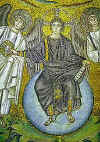
During the late sixth century artists began representing Christ's image in various media so that it had many uncanny similarities to the image on the Shroud of Turin. See the photographs of the face of the man in the Shroud and its negative image below right.2
French scholar Paul Vignon, was
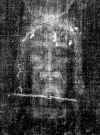 one
of the first to notice these
one
of the first to notice these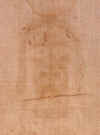 similarities and catalogued at least 15 distinct markings that many of the icons
have in common with the Shroud image. Three of the most common markings are a
topless square between the eyebrows, a "v" shape at the bridge of the nose, and
two wisps of hair.3
similarities and catalogued at least 15 distinct markings that many of the icons
have in common with the Shroud image. Three of the most common markings are a
topless square between the eyebrows, a "v" shape at the bridge of the nose, and
two wisps of hair.3Dating from ca. 590 is one of the earliest and most beautiful icons, the Christ Pantocrator, pictured below left from the Monastery of St. Catherine at Mt. Sinai. It is painted in encaustic, an early technique involving
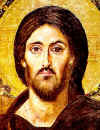 beeswax.4
beeswax.4 Using a Polarized Image Overlay Technique that they developed Whanger and Whanger (1998:20) discovered 170 points of congruence between the St. Catherine's Pantocrator icon and the Shroud face. In a court of law the forensic standard for fingerprints is 14 points of congruence, for faces 45-60.
During the first reign of the Byzantine emperor Justinian II (685-695), the first known coinage to feature Christ's portrait
 appeared. The gold solidus at right dates from ca. 690.5
appeared. The gold solidus at right dates from ca. 690.5 The Whangers (1998:20) found 145 points of congruence between the Justinian solidus and the Shroud face. This evidence strongly suggests the Shroud as the model for both the Pantocrator icon and the Justinian solidus.6
Three of the most famous icons exhibiting several of the Vignon markings can be seen below. The left image is the Christ Pantocrator
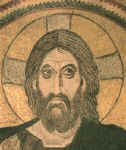
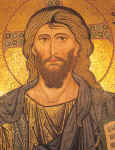
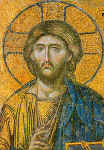 mosaic
(ca. 1050-1100) from the dome of the Church at Daphni, near Athens. Notable are
the "v" shaped triangle at the bridge of the nose, and a stylized version of the
topless square.7
mosaic
(ca. 1050-1100) from the dome of the Church at Daphni, near Athens. Notable are
the "v" shaped triangle at the bridge of the nose, and a stylized version of the
topless square.7
The Christ Pantocrator, (ca. 1148 C.E.) from the mosaic in the apse of Cefalý Cathedral, Cefalý, Sicily can be seen in the middle image. It has exaggerated strands of hair and also the stylized "v" and topless square.8
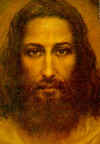
The above right image is a detail from the mosaic of the Deesis from the south gallery of Hagia Sophia in Istanbul. Most of the markings are present, though the strands of hair are missing. This mosaic dates from ca. 1260-1280, around the earliest date given for the Shroud from the Carbon 14 dating.9
Armenian artist P. Ariel Agemian created at right this modern "icon" in 1935 using the Shroud image as his model.10 This image is probably one of my favorites. For animations of the positive and negative images of the Shroud morphing into the Agemian portrait, see Linceul de Turin and Holy Shroud Guild.
The image at left is obviously a composite of the Agemian and the Shroud negative image. It was allegedly made in 1978 by NASA engineers.11 However, it has been claimed by some to be a miraculous manifestation by the Indian spiritual master Sai Baba. No further comment is really necessary.